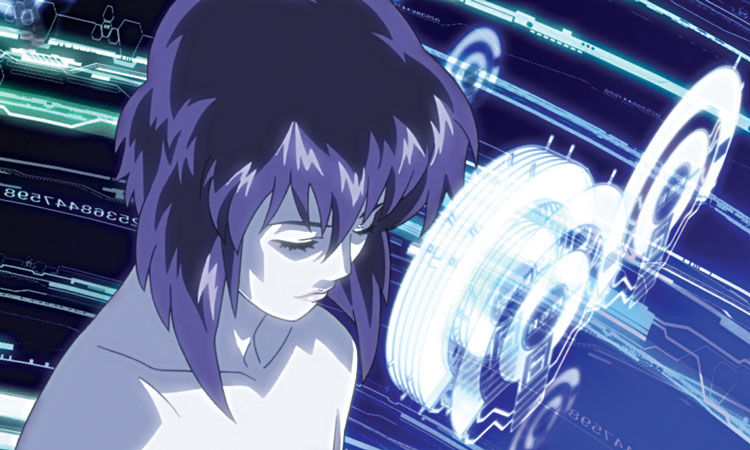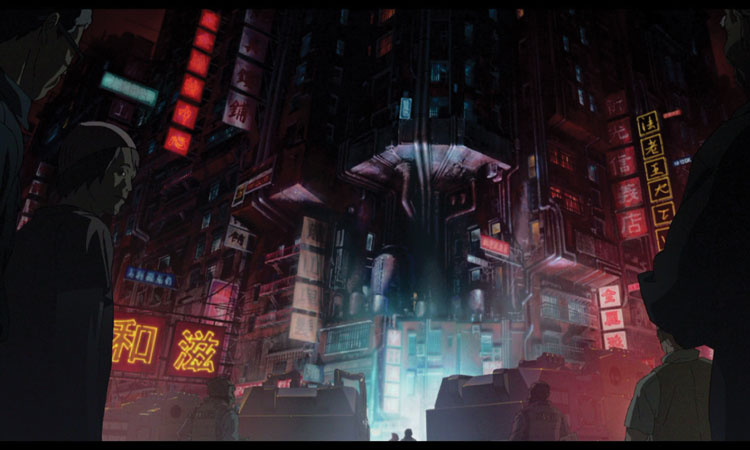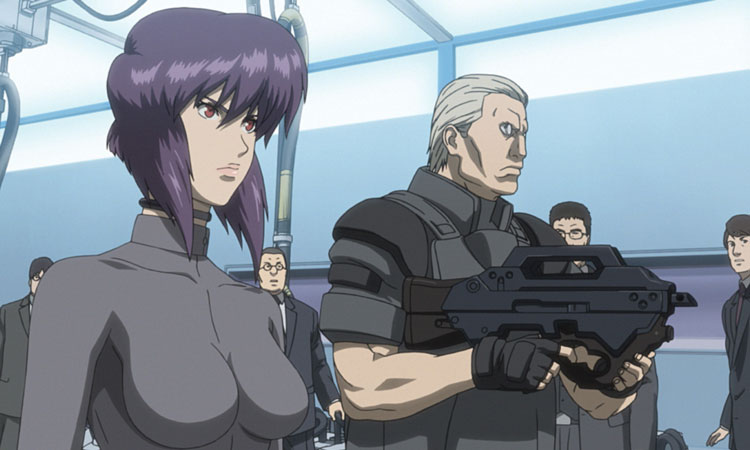In 1995, the image of Japanese animation in Britain was very different from what it is now. It was before Pikachu and Naruto, before Death Note and Cowboy Bebop. Studio Ghibli was around in Japan, but only hardcore anime fans knew about it in Britain. The national media called Japanese animation ‘manga movies’, ignoring fans’ protests: “But manga are Japanese comics, not animation…”
Manga movies were known for comic-book action, brutal violence, and shocking sex. Musclemen hulked out in bone-splintering fights, their faces exploding in rivers of blood. Women were butt-naked in ways to make Barbarella blush. One ‘manga movie’, Wicked City, had a seductive woman who turned into a spider creature with a ravenous vagina dentata maw. Many of these releases were 18-rated, though that didn’t stop British kids, the rapscallions. Gareth Evans, who directed the two Raid films, confessed he saw the notorious Legend Of The Overfiend when he was 11.
In the middle of all this, a striking woman hero emerged from the manga movie crowd. She was called Major Kusanagi and she didn’t simper or scream. She was calm, composed, a rare adult woman in a medium notorious for Lolita fixations. She didn’t depend on any man. She was an assassin who leapt down buildings and blew people’s heads off, but she had no bloodlust; she was just a lethally good pro.
She had a robot body but a (partly) human brain, a triumph of technology who was still her own person. In most versions of Ghost In The Shell, we don’t even meet the creator of her artificial body; it’s not important to the story. It’s telling that Hollywood changed this. In last year’s live-action remake, Scarlett Johansson’s Major (renamed Mira Killian, to the disgust of fans) is designed by a scientist played by Juliette Binoche, who’s significant in the film.
In real life, the Major had many creators. Ghost In The Shell is a very strange ‘franchise’ by Western standards. It was reinterpreted by a succession of creators, each of whom had his own strong take on the property. If Ghost was an American property, these voices would have been probably reined by company executives, forced to keep to a series bible or to go where the market demanded. But with Ghost, they had free rein to take the story in different ways, following their respective interests.
The best-known version of Ghost In The Shell is the first film, released in 1995, directed by Mamoru Oshii and animated – like all the Ghost anime made since – by the studio Production IG. The film introduces Kusanagi and her police team, Section 9, fighting crime that’s arisen from new tech. This is a world where more and more people, especially those in business and political elites, are choosing the benefits of cyber-technology. Many opt to become full cyborgs, like Kusanagi. Decanted into artificial bodies, their human brains are wired up, computer-enhanced… and vulnerable to hacking.
Criminals can rewrite people’s memories, fabricate identities and stamp over the human self. A thug can be hacked, convinced he’s a deadly terrorist, given the weapons skills to match and sent on an assassination. In a chilling scene in the film, a luckless garbage man learns he was given memories of a life and family which never existed. Kusanagi’s adversary, it seems, is a super-hacker called the Puppet Master, who uses one mind-altered stooge after another.

Later, though, there are rug-pulling revelations about what the Puppet Master actually is, and the film becomes a conspiracy thriller. Next it dives into spirituality with shades of 2001: A Space Odyssey, culminating with an event that’s simultaneously a rebirth for the main character and the birth of a new life-form. The merged creature is last seen contemplating an unfurling universe.
That’s how Akira had ended too, and Ghost was supposedly Akira’s successor. Manga Entertainment, a British distribution label that was created specifically to market films like Akira, contributed about a third of Ghost’s budget. As a property, Ghost looked like Manga’s bread and butter. There was a future shock world, action and a sexy female lead. And the 1995 film provides all of that… but not in the way that Akira fans would expect.
In the film’s first scene, Kusanagi appears to strip naked before her Bond-style hit mission. Except that her body is no more detailed than a mannequin’s; she’s actually wearing a ‘nude’ body stocking, which allowed Scarlett Johansson to replicate the moment in a 12-rated film two decades later. In the anime, Kusanagi’s on a hit mission. She shoots a diplomat whose head explodes… and we see that the insides are robotic. Both moments masquerade as exploitation – a striptease, a gory gross-out – but they’re presented ambiguously, more confusing than titillating.
Ghost is certainly full of action, much of it lovingly recreated in the Hollywood version. There’s an ear-ringing shoot-out with a terrorist heavy (or at least he thinks he’s a terrorist), who’s pushed backwards along Tarmac by the force of the bullets he’s firing. An invisible Kusanagi duels with the goon in a silent flooded arena, and takes him down with exquisitely balanced killer moves.
The fight is savage and mellow, as is the film’s iconic climax. Here Kusanagi grapples with an armoured tank in a ruined museum modelled on a piece of British Victoriana, the Crystal Palace. Watching the combatants strain against each other, you can’t tell where human ends and machine begins. A mournful ululating score by composer Kenji Kawai (Ringu) gives the fight the detachment of a sad dream.
At times, Ghost feels closer to a European ‘art’ picture than it does to Akira or Blade Runner. One much-analysed sequence, bang in the middle of Ghost, is a wordless three-minute tone poem. The Major passes silently along urban canals and sees her mass-produced face on strangers and shop-window dummies. Then rain pours down, changing the film’s estranged ennui into fervid ecstasy, foreshadowing the wondrous meeting awaiting Kusanagi.
Throughout his work, the film’s director, Mamoru Oshii, has been less interested in action than in reflection, and in unconventional storytelling. His version of Ghost has many points in common with a film he made two years before, Patlabor 2, which also has police, robot technology, and lyrical landscapes.
Yet for all of Ghost’s arty credentials, non-anime fans may be thrown out of the film by the ‘manga movie’ trappings, the violence and nudity. SciFiNow asked Jonathan Clements, who wrote the BFI book Anime: A History, how he would introduce Ghost to someone who loves serious SF but who isn’t an anime fan.
“I’d say,” says Clements, “that the Hugo Award nominees for Best Dramatic Presentation in 1996 included Toy Story, Apollo 13, and episodes of Babylon Five and DS9… but I’d defy anyone to suggest that Ghost In The Shell didn’t deserve to be on that ballot as well. Surely, when the SF community is pushing for diversity and internationalism, there should be space in the canon of ‘serious SF’ for films like Ghost In The Shell. It’s thoughtful, smart science fiction, sometimes a decade or more ahead of real-world issues in identity theft, big data, viruses and fake news.”
Nine years later, Oshii returned to the Ghost world with a sequel, Ghost In The Shell: Innocence. It’s a controversial film, though no-one could accuse Oshii of selling out. The sequel’s focus isn’t on Kusanagi but on her cyborg colleague and confidant, the heavy-built Batou. Like the Major, Batou transcends anime stereotypes. He’s physically imposing but he’s no simple he-man, deeply respectful of Kusanagi, always at her back. Innocence, though, shows a glum Batou who lost Kusanagi in the first film. Now, he’s investigating killer sex-droids; the trail leads to organised crime, corporate conspiracies and a guardian angel.
Innocence is an extremely arty picture. The CG visuals are stunning, but many viewers were flummoxed by a film where, as one critic put it, characters burst into philosophical discussion as readily as Disney princesses burst into song. Characters talk endlessly of the differences between humans, animals, dolls, even gods, and how they all reflect one another (the film shows a spectacular festival in which gods are massive dolls, based on an event in Taiwan).
If you’re patient with Innocence, there are links between its philosophising and its mystery story, adding up to a poignant thesis on humanity. Many viewers, though, thought Innocence was a woeful sequel to Ghost.

Jerome Mazandarani, Managing Director of Manga Entertainment, remembers his struggle to market the film: “Innocence was a hard sell because it is a deeply flawed film made by a deeply flawed filmmaker,” Mazandarani says bluntly. “Too philosophical and not enough action. It disappointed commercially. Movies need beats and projects like Ghost require set-pieces. Innocence is beautiful and esoteric and a classic in its own right, but damn, it plods along. It also fails to get under the bonnet of the team by only focusing on Batou – who is one of my favourite characters, but I wanted more adventures with the Major.”
The first Ghost film was scripted by Kazanori Ito, who’d also written Patlabor 2. By the time of Innocence, Oshii had fallen out with Ito; the sequel’s script is credited to Oshii alone. “I have always thought that Oshii is better with a co-writer,” says Mazandarani. “If Production IG couldn’t reign in Oshii and his more self-indulgent impulses, why did they give him the job in the first place?
“Ghost In The Shell transcends any one creative voice,” Mazandarani claims. “Stand Alone Complex is a success primarily because Kenji Kamiyama wrote and produced it.”
Stand Alone Complex, the TV version of Ghost In The Shell, debuted shortly before Innocence (it launched in 2002) and was a very different take on the property. Fifteen years younger than Oshii, Kamiyama was a protégé of the older director, trained by Oshii in a study group. After several team credits on various anime, Kamiyama was rocketed into directing a TV series that could stand up as a viable alternative to his mentor’s famed film.
“My aim is to target the masses,” Kamiyama said in an interview about Stand Alone Complex with Anime News Network. “The complicated background stories and settings together with the seriousness of the storyline is as high quality as the (first) film. But as this is a TV series, rather than making an artistic work, we had to consider the excitement within each episode and to be careful that stories will appear relatively easy to understand. But we do have social criticism in our work.”
Certainly, Stand Alone Complex is far more mainstream than Oshii’s films. In place of Oshii’s arthouse flourishes, his brooding, lonely protagonists, Stand Alone Complex is a true police procedural. The Section 9 team is shown operating as a unit, combining its members’ diverse skills. While Kusanagi and Batou are still central characters, there’s more space given to Togusa, a still-human police officer newly transferred to the team, who’s often our viewpoint on this world (Martin Freeman would have been ideal live-action casting).
Other Section 9 members, who were barely glimpsed in the Oshii films, include info-warrior/hacker Ishikawa (burly, bearded) and the lean sniper Saito. Unlike many Western police procedurals, the show foregrounds these characters’ professional skills, not their quirks or personal problems. The pleasure of the series is seeing them work as a functional team, not arguing and messing up.
But there are humanising touches throughout the show. In the first episode, when the team’s about to raid a restaurant full of rogue murderous robot geisha, Batou quips if the geisha will entertain him as a customer, while Kusanagi grimaces in annoyance (the subsequent shoot-out is adapted in the live-action film, but without the joke). Soon after there’s a sweet moment when Kusanagi sees the rookie Togusa at target practice, clearly worried if he’s Section 9 material; she both chides and reassures him. Such touches confirm we’re in a very different Ghost from Oshii’s films, with humour and warmth.
For Mazandarani, Stand Alone Complex was far easier to market than Innocence, and a truer successor to the 1995 film. “By the time Manga started releasing the series on DVD in the UK, the hype for Stand Alone Complex had already spread into the English-speaking world,” Mazandarani says. “It’s a perfect TV series executed with precision, a stunning achievement in animation and long-form television production and planning. It’s still one of my favourite anime ever.”

Mazandarani says the show’s success was down to a mix of factors, such as the fleshing out of the Section 9 team and its complex adversaries. The loveable ‘Tachikoma’ robots often stole the show, looking like giant metal grasshoppers and talking like delighted children. Then there was the show’s music, written by perhaps the most famous composer in anime: Yoko Kanno, who’d scored Cowboy Bebop. Her theme song for Stand Alone Complex’s first season, ‘Inner Universe’, was a torrent of percussive beats, overlaid with powerhouse female vocals by Russian singer, Origa. Origa also performed the second season’s song, Rise; she died in 2015, aged just 44.
While Stand Alone Complex did not have the copious ‘nudity’ of Oshii’s films, Kusanagi often wore a brashly brief leotard, as if to remind viewers this was anime. It may have thrown some viewers out of the series, but Mazandarani says Kusanagi “got a lot of love” from female fans and became a cosplay favourite at conventions.
“Kusanagi is a fully formed protagonist whose sexuality and gender are only part of the wonderfully complex character mosaic,” Mazandarani says. “She feels real. Why wasn’t this character a watershed for the depiction of women in anime?” Mazandarani blames the rise of ‘moe’ (pronounced mo-e), a trend for excessively cute girl characters in manga and anime. “Moe came along like a tsunami and swept this all away. It makes me depressed to think about it.”
Kusanagi herself would grow younger in the next Ghost In The Shell anime after Stand Alone Complex. Ghost In The Shell: Arise debuted in 2013 as a quartet of video films, running 50 minutes each. Later Arise was re-edited as a TV series (subtitled ‘Alternative Architecture’), including a fifth story, ‘Pyrophoric Cult’. Next, Arise graduated to cinema with the misleadingly-named Ghost In The Shell: The New Movie. The film ties up strands from the earlier Arise stories, but it isn’t recommended if you haven’t seen them.
Arise depicts younger, less experienced versions of the Ghost characters, suspiciously getting to know each other for the first time (an obvious franchise comparison is Batman: Year One). Thanks partly to the characters’ verbal sniping, the tone is bleaker than Stand Alone Complex, less composed than Oshii’s films. Full of murders and atrocities, Arise was mostly directed by Kazuchika Kise, a prolific animator with relatively few director credits. However, the stories seem to reflect the worldview of Arise’s writer, Tow Ubukata, whose other work often skews into horror.
Still, The New Movie ends on an upbeat note, with the sense of a franchise coming full circle. It opened soon before the announcement of another Ghost In The Shell film, the Hollywood version with Scarlett Johansson. This was soon embroiled in controversy for its ‘whitewashed’ casting. As the British marketer of several previous Ghosts, Mazandarani used to defend the casting of Johansson as the Major; he’s since changed his mind.
“I was absolutely and completely wrong,” says Mazandarani. “My argument was that there’s no way a $120 million movie could be a success without a proven action-heroine like Johansson in the lead. On a box office economic level that may be true, as investors want to avoid all risk, but I think a better film could have been made on a smaller budget and with the right casting and it would likely have been much more successful, not just as a movie but also as a future franchise. Can you imagine what the film would have been like had it gone into production after Black Panther and with a truly diverse cast?”
The Johansson version of Ghost flopped, but badly-received Hollywood adaptations do little harm to their source franchises – look at Dragon Ball or Airbender.
Today’s technology is profoundly different from when the first Ghost debuted; so is the anime landscape, which stretches from Attack On Titan to Mary And The Witch’s Flower to another Hollywood remake with an artificial woman – Alita: Battle Angel.
And yet there’s still a place for anime’s cyborg First Lady. “Technology might have changed,” acknowledges Jonathan Clements, “but the engagement that Ghost has with it hasn’t dimmed.” New tech just gives Major Kusanagi the chance to reinvent herself again.
The Ghost In The Shell films and Stand Alone Complex are available on Blu-ray from Manga Entertainment.
